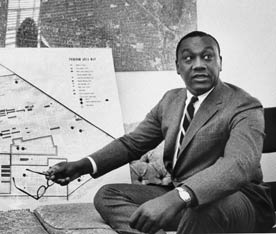Community development organizations (CDOs) have always had to deal with the problems caused by the loss of the businesses in their neighborhoods. But in the 1980s and 1990s, more businesses began to show greater interest in low- and moderate-income communities. The federal Low Income Housing Tax Credit Program, started in 1986, made affordable housing more cost-effective for developers. Also, in the 1990s, the saturation of retail in the suburbs and the prospect of gentrification in older urban communities encouraged more businesses to market to and locate in communities they would have fled from 20 years earlier. What’s more, the business world began to compete with community development organizations for talented professionals. CDO leaders now had to offer more benefits, which put more pressure on them to focus on the business side of their work.
As community development organizations became more successful, they also increased the expectations of funders, stakeholders, and partners. It was no longer enough for executives to tell and sell wonderful visions; they had to prove that they could reach their destinations efficiently and effectively.
As the nonprofit sector was becoming more corporatized, businesses were becoming more like communities. Management experts such as Peter Drucker, Peter Senge, and Warren Bennis were convincing corporate executives to listen to their employees and give them more opportunities to influence the direction and values of their firms.
These thinkers also saw that the world of business and organizations was moving too fast for any one person to manage all the information needed to make informed decisions. The Internet and other technologies were making more information available, but also speeding up the pace at which clients and customers expected answers. Globalization meant that businesses were affected by economic changes anywhere in the world. For community development organizations, this meant that businesses could move in and out of communities more easily and that neighborhoods could be inundated with immigrants from countries that may have been unknown to existing residents. Few captains could adapt quickly enough to these changing weather conditions.
“Some of our most successful community development organizations were started by community organizers who were able to develop the [necessary] business skills,” said George McCarthy, a senior program officer in development finance and economic security at the Ford Foundation, who administers a program that focuses on using homeownership to build assets for low-income families and their communities. “As we professionalized community development, we began to select for folks with business skills to scale up and manage the enterprises. But as we pass the torch of leadership from the organizers to the business managers, we’re missing some of the key talents that the previous leaders brought from the community organizing side.”
Community Development in the 21st Century: Strike Up the Band
The world of community development today makes it difficult for a senior manager to be a captain. There are too many challenges and opportunities — too much information, period — for one person in a growing organization to manage. The key, Fernandez says, is “letting go as a leader. You have to nurture and develop your senior management team.”
“Lots of stakeholders expect more [from community development organizations],” Wade says. “Government stakeholders are expecting community developers to produce more.”
“You’re not going to get by with low levels of productivity,” he adds. “The standards are higher and the pressures are greater. There is more attention paid to the professionalization of the field.”
The successful community development leader of the 21st-century organization is likely to be a lot like a band leader—responsible for making the different sounds of various instruments come together in harmony. Band leaders coordinate with their musicians but can’t control how well they play on any given day. Musicians have to be motivated to bring their art to their highest levels. And like all creative professionals, they want the independence to make their own contributions to the band. The successful bandleader motivates as well as directs.
In the late 1960s, community development organizations struggled to get banks to offer mortgages in low-income communities. Today, CDOs work hard to help low-income residents avoid getting trapped by predatory lenders. In the 1970s, CDO leaders organized residents to demonstrate against absentee landlords and uncaring banks. Today’s CDO leaders are just as likely to be landlords (albeit better than the ones they replaced) and to sit with bank directors who would like to provide loans or grants. In the late 1970s, a CDC was one of the few attractive places for a community-oriented professional who didn’t want to work for government. Today, that professional might be just as likely to work for the social-investment arm of a major corporation.






Comments